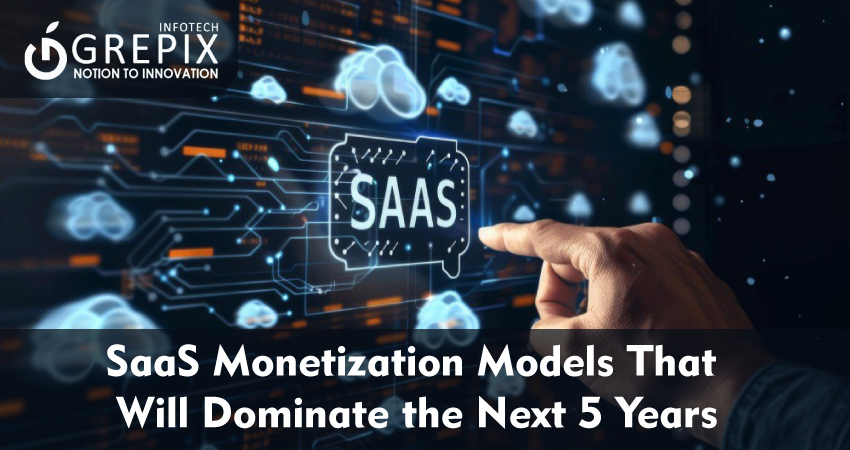SaaS Monetization Models That Will Dominate the Next 5 Years
Did you know that over 70% of SaaS startups fail within the first five years, often because they can’t find the right monetization strategy? With competition heating up and customer expectations changing faster than ever, choosing the right SaaS Monetization Models isn’t just a financial decision—it’s a survival strategy.
Whether you’re building your first SaaS based product or optimizing an established platform, the next five years will bring new trends, new customer behaviors, and new opportunities.
In this guide, we’ll explore the SaaS models that will dominate the future, with practical examples, case studies, and insights from the world’s top SaaS companies.
SaaS monetization is evolving rapidly, and the next five years will be defined by models that align revenue with customer value. While subscription-based pricing remains the backbone of SaaS, freemium strategies, usage-based billing, and tiered pricing are gaining momentum. Hybrid monetization—combining subscriptions, pay-as-you-go, or ad-supported options—is set to dominate as businesses seek flexibility and scalability. Transaction-based models are thriving in e-commerce and fintech, while outcome-based pricing is emerging as a trust-driven approach. Real-world success stories from Zoom, Salesforce, and Twilio highlight how different models fuel growth. Future trends point toward AI-driven pricing, micro-subscriptions, and Web3 payments, ensuring SaaS based products remain competitive in a crowded market. For startups and enterprises alike, choosing the right SaaS model is critical for growth, profitability, and investor confidence. The winners will be those who balance customer satisfaction with sustainable, scalable monetization strategies.
Why SaaS Monetization Matters More Than Ever
- Recurring revenue is king: Predictable cash flow keeps investors and founders confident.
- Customer retention acquisition: With acquisition costs rising, retaining users through the right pricing model is crucial.
- Market saturation: With 30,000+ SaaS products in the market, differentiation comes from how you charge, not just what you offer.
A strong SaaS monetization model helps you balance growth, customer satisfaction, and profitability.
Top SaaS Monetization Models for the Next 5 Years
1 Subscription-Based Pricing (Still the Leader)
The most common SaaS model, where customers pay monthly or yearly.
Why it dominates:
- Predictable revenue.
- Easy upgrades/downgrades.
- Works across industries (CRM, HR, project management).
Examples:
- Slack – Per-user monthly subscription.
- Netflix – Flat subscription, unlimited access.
Best For: SaaS based products with wide adoption and ongoing value delivery.
2 Freemium Model With Premium Conversions
Freemium isn’t new, but it’s evolving. Instead of giving away too much, SaaS companies now focus on:
- Limited features free.
- Premium features (automation, integrations, analytics) behind paywalls.
Case Study:
Zoom exploded during the pandemic by offering free 40-minute calls, then nudging users to upgrade.
Pro Tip: Balance between free and paid so users see value but crave more.
3 Usage-Based Pricing (Pay-As-You-Go)
Customers pay based on actual usage—API calls, storage, or transactions.
Why it’s growing fast:
- Aligns cost with value.
- Lowers entry barrier for startups.
- Favored in cloud, DevOps, and AI SaaS models.
Examples:
- AWS – Pay per compute/storage hour.
- Twilio – Pay per SMS or API call.
Best For: Developer tools, cloud SaaS, and AI SaaS based products.
4 Tiered Pricing With Value Metrics
Companies offer multiple pricing tiers based on features, users, or storage.
Why it works:
- Appeals to different customer segments.
- Helps SaaS companies upsell effectively.
Example Pricing Table:
| Tier | Price/Month | Features |
|---|---|---|
| Starter | $10 | Basic features, 1 user |
| Growth | $49 | 10 users, integrations, analytics |
| Enterprise | Custom | Unlimited users, advanced security |
5 Transaction-Based Revenue
Instead of subscriptions, SaaS platforms take a percentage of every transaction.
Examples:
- Shopify – Monthly fee + transaction fees.
- Stripe – Per transaction commission.
Why it matters: Works best for SaaS based products supporting e-commerce, marketplaces, and fintech.
6 Hybrid Monetization (Mixing Models)
The future is hybrid SaaS models:
- Subscription + usage-based.
- Freemium + ads.
- Tiered + transactional.
Example:
- Spotify – Freemium with ads OR subscription with premium features.
Why it’s growing: Combines stability of subscriptions with scalability of usage-based pricing.
7 Outcome-Based Pricing
Instead of paying for access or usage, customers pay for results.
Examples:
- Marketing SaaS charging per qualified lead.
- Security SaaS charging per threat detected.
Why it’s emerging: Increases trust and shows accountability.
8 Ad-Supported SaaS Models
Free SaaS based products supported by ads.
Examples:
- Canva’s free plan shows upsell ads.
- Spotify free users see ad banners.
Best For: Mass-market SaaS products with high user engagement.
Future Trends in SaaS Monetization (2025–2030)
- AI-driven dynamic pricing – adjusting fees in real-time based on demand.
- Crypto & Web3 monetization – SaaS billing in Bitcoin, Ethereum, or stablecoins.
- Micro-subscriptions – $1–$3 niche tools sold via app stores.
- Personalized pricing – based on company size, industry, or activity.
- API-first SaaS monetization – charging per integration used.
Answering Key People Also Ask (PAA) Queries
Q: Which SaaS monetization model is best?
A: It depends. For B2B, tiered pricing works best. For developer tools, usage-based SaaS models dominate. For mass-market apps, freemium is ideal.
Q: How do SaaS companies make money?
A: SaaS based products earn through subscriptions, pay-as-you-go usage, freemium upgrades, or transaction fees.
Q: What is the difference between subscription and usage-based SaaS models?
A: Subscriptions charge fixed recurring fees, while usage-based pricing charges for actual usage.
Real-Life Case Studies
- Zoom: Freemium → scaled to 300M daily users.
- Dropbox: Referral-based freemium growth.
- Salesforce: Subscription + enterprise tiered pricing → $30B revenue.
- Twilio: Usage-based → revenue tied directly to customer success.
Comparison of SaaS Monetization Models
| Model | Revenue Predictability | Customer Acquisition | Scalability | Risk Level |
|---|---|---|---|---|
| Subscription | High | Moderate | High | Low |
| Freemium | Medium | High | High | Medium |
| Usage-Based | Variable | High | Very High | Medium |
| Transaction-Based | Variable | High | High | High |
| Hybrid | High | High | Very High | Medium |
| Outcome-Based | Low (for now) | Low | High | High |
Internal Linking Ideas
- Link to: “How to Build a SaaS App in 2025”
- Link to: “Cost Breakdown of Building a SaaS App”
- Link to: “Cloud Costs vs Control: Choosing the Right Strategy”
External Authoritative Links
- Gartner SaaS Market Forecast
- Statista SaaS Market Size
- McKinsey SaaS Pricing Insights
Conclusion: The Future of SaaS Monetization
The next five years will reshape the SaaS monetization landscape. Subscription models will remain strong, but freemium, usage-based, and hybrid SaaS models will gain dominance. The winners will be SaaS based product that align their monetization with customer value—whether through flexibility, transparency, or innovation.
If you’re building a SaaS startup today, choose a model that matches your audience’s willingness to pay and your long-term scalability goals.
Ready to take your SaaS idea to the next level? Let’s build your future-ready SaaS product today!
FAQs
1. What is AI-driven DevOps?
AI-driven DevOps uses artificial intelligence to automate pipelines, predict failures, and optimize deployments.
2. Why is observability critical in 2025?
Because systems are distributed and complex, observability ensures full visibility into metrics, logs, and traces.
3. How do AI pipelines differ from traditional CI/CD?
AI pipelines can predict failures, auto-scale, and provide proactive fixes, unlike manual CI/CD.
4. Which tools support AI in DevOps?
Popular tools include Jenkins AI plugins, Dynatrace, Datadog, New Relic, and Azure DevOps with ML.
5. Is AI replacing DevOps engineers?
No, AI is augmenting engineers by automating repetitive tasks and allowing them to focus on innovation.
Launch your vision with our mobile app development company, where innovation meets excellence to create cutting edge mobile solutions."







